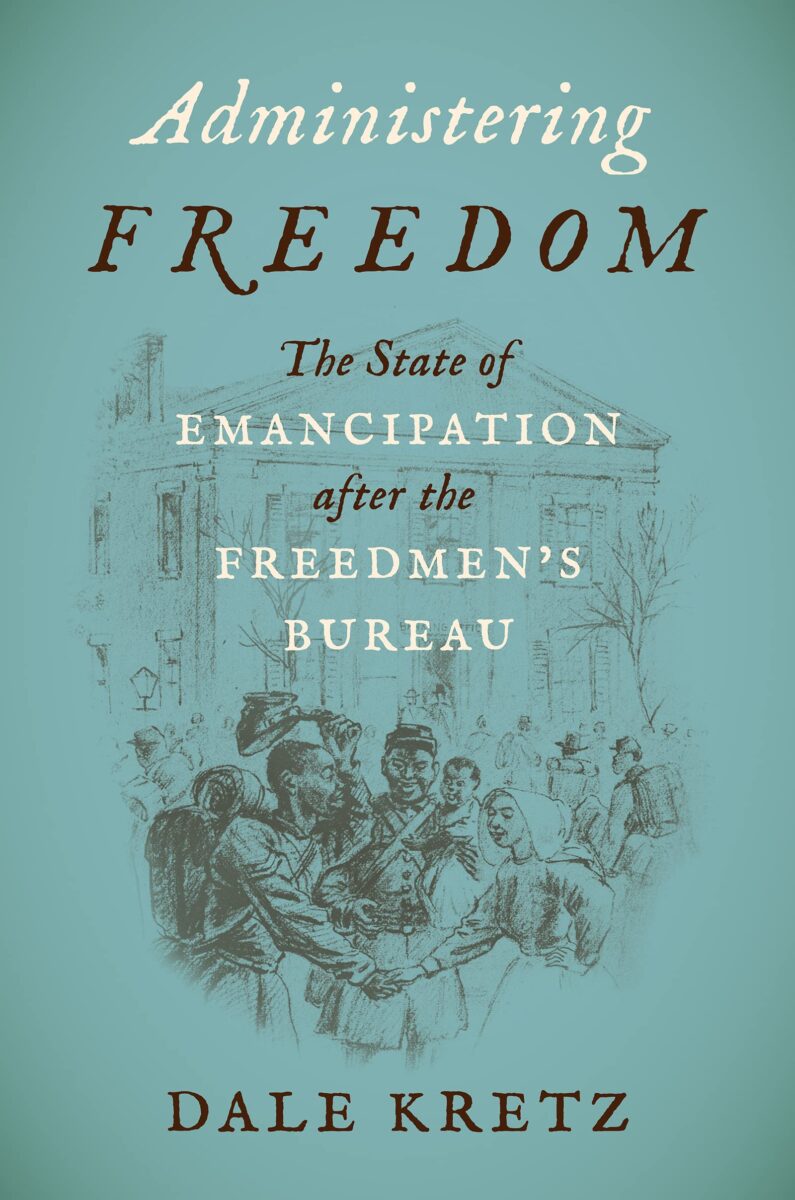Administering Freedom opens by recalling William Baltimore’s interview with a member of the Federals Writers’ Project in the late 1930s. Baltimore fled to the Union Army in 1863, enlisted in the Fifty-Fourth U.S.C.T. in Little Rock, marched throughout the trans-Mississippi West, and, decades after the war ended, applied for a federal pension. Just as pensions provide an important lens into the lives of Black people, the extensive number of documents each claimant compiled in order to support their pension application also merits attention. Some claimants could not gather enough information to meet the evidentiary requirements, but “to simply regard such loss in negative terms—for the claimant and the historian—is to miss its fundamental basis in one of the most profound transformations in nineteenth-century America: the long, frustrating, and at times painful process by which millions of stateless people became documented citizens” (2).
Dale Kretz, currently a labor representative for the California Nurses Association, argues that “understanding freedom as a condition to be managed by the federal administrative state offers a new perspective on emancipation and Reconstruction” (2). When William Baltimore and other African Americans fled to Union lines, they “did not simply enter into an already existing relationship with the central state; they were building a new one” (3). The Bureau of Refugees, Freedmen, and Abandoned Lands—also known as the Freedmen’s Bureau—played an important role in the construction of this new relationship. Congress created the Freedmen’s Bureau in March 1865 and passed a bill in 1866 to extend the Bureau’s lifespan. The Freedmen’s Bureau, scholars have demonstrated, often mediated between African Americans and white Southerners. Although chronically understaffed, the Bureau became a critical, if inconsistent, ally for African Americans. However, the Bureau ceased operations in 1872. The relationship between freedpeople and the federal government certainly did not end with the Bureau’s demise, but it did change and “the way it changed, the way emancipation was managed every day for the next seven decades, depended on the continued political exertion of tens of thousands of formerly enslaved men and women” (4).
Administering Freedom argues that “the promise of emancipation was not simply crushed in the early years of Reconstruction but rather was forcibly pushed through the sieve of the federal administrative state, which itself grew in large measure as a way to manage the expectations of freedpeople and delimit the boundaries of freedom in the new liberal order” (8 – 9). Kretz examines the actions of federal bureaucrats and officials, but also highlights, whenever possible, “the often subtle and submerged but nonetheless deeply significant administrative politics of thousands of ordinary freedpeople as they used their unique position as long-standing federal claimants to refashion their political identities as entitled, rights-bearing citizens” (10). Administering Freedom offers readers a “statist history of emancipation and Reconstruction as experienced by tens of thousands of ordinary freedpeople” (12).
Kretz begins by discussing the final days of the Freedmen’s Bureau and contends that scholars have “missed a vital part of the story of emancipation and, indeed, the very struggle for Black citizenship waged by the formerly enslaved themselves, for the way in which the bureau closed had important implications for the parameters of citizenship in the new nation-state” (15). Bureau officials, for example, often distributed rations in bulk to planters and, consequently, reinforced “the economic dependency of freedpeople on their employers, a relation grounded in the broader failure of land reform” (41). Still, even as the Bureau’s operations concluded, Black people continued the Bureau’s work, and many pressed the government to fulfill promises of bounty payments. Ironically, as the Bureau downsized, it also assumed the responsibility of facilitating claims for bounty payments. Freedpeople, Kretz argues, worked collectively to provoke bureaucratic action and their widespread engagement and agitation forced the Bureau to “maintain its commitment to this least measure of hope” (57). The letters of freedpeople could and did affect change in the corridors of power in Washington, D.C.
Most scholars of the U.S. Civil War and Reconstruction know a great deal about the Freedmen’s Bureau. Far fewer have heard of the Freedmen’s Branch, the organization established in 1872 to assume the Bureau’s unfinished work. Nevertheless, for all that scholars have overlooked the Freedmen’s Branch, it was, for tens of thousands of African Americans, “of immense importance to their livelihoods and was widely recognized as the vestigial connection to federal power” (58). Despite numerous scandals and injustices, freedpeople continued to pursue their claims. Many white Southerners deplored the Freedmen’s Branch, just as they had detested the Freedmen’s Bureau. That said, some former enslavers “saw freedpeople’s claims as an opportunity to extend their wardship as intercessors for the federal administrative state” (91). The Freedmen’s Branch ended operations in 1879 after paying thousands of claimants. “The narrow focus on claimants and claim fulfillment,” Kretz asserts, “came to stand in for broad-based, redistributive reforms in the post-Civil War South” (97). Furthermore, the Freedmen’s Branch “set a precedent for federal endeavors in welfare that were at once invasive in their means and limited in their benefits, an insidious way to discourage participation in a program whose outright abolition as too political unfeasible” (99).
After analyzing the Freedmen’s Bureau and the Freedmen’s Branch, Kretz turns to African American efforts to acquire federal pensions, a process that required “far more of Black claimants than their previous struggles for bounties, and for far longer” (100). Importantly, “more so than any other federal agency in the decades after the Civil War, the Pension Bureau symbolized the possibilities and limitations of the reconstructed nation-state” (100). That said, claimants who had been enslaved faced significant challenges in securing pensions. Scholars often focus on men applying for pensions, but Kretz demonstrates how Black women’s efforts to claim pensions “played on oversized and underappreciated role in negotiating the meaning of dependency and challenging the limitations of the new liberal order” (101). Through their persistent applications for pensions, freedwomen proved to be formidable actors in the emerging administrative state.
Kretz also takes readers deep into the process of claiming a pension. Unsurprisingly, the Pension Bureau favored documentary evidence from medical officials. Claimants often had difficulty securing witness testimony. Former enslavers played an ambiguous role as freedpeople claimed pensions from the federal government. Tens of thousands of pension cases involving formerly enslaved people, Kretz remarks, “represented national reconciliation struggles writ small” (186). When Republicans passed the Disability Pension Act in 1890, African Americans newspapers celebrated the fact that the Act covered “the thousands of Black veterans and heirs struggling to obtain their pensions under the old system” (202). Kretz reinforces a point he made earlier, namely, that freedpeople were not passive observers. He also pays attention to the class dimensions of this story. Members of the Black professional class often found the Pension Bureau to be an avenue of public sector advancement. Other African Americans resented the byzantine procedures, the seemingly-never ending paperwork, and excessive scrutiny. Changes in pension policies and procedures in the three decades after the end of the U.S. Civil War, Kretz contends, precipitated “nationwide debates over the proper role of the federal government in providing for its citizens who had sacrificed on its behalf” (232).
Kretz’s final chapter discusses the movement to pension all former slaves, which drew heavily on another movement—namely, Black Populism. Many Southern white people reacted viciously and violently to Black Populism, and the federal government worked to destroy the movement to pension all former slaves. Nevertheless, “in spite of the relentless federal assault on the movements and its leaders, and in spite of an almost universally hostile press, the embattled ex-slave pension movement continued apace in the early years of the new century” (266). Many people criticized this movement, but opposition was never universal. Some white southerners also hoped that the federal government would pension ex-rebels. In the end, the movement to pension all former slaves and the more sporadic attempts to pension ex-rebels did not succeed. “Of all the lessons to be learned from the world-making and as-yet-unfinished history of emancipation in America,” Kretz concludes, “few have been more obscured than the interminable struggle against the administrative diminution of freedom waged in contest and concert by the freedom generation” (301).
Administering Freedom begins where some scholars have ended their accounts: the shuttering of the Freedmen’s Bureau in 1872. From there, the book examines freedpeople’s interactions with the Freedmen’s Branch and the Pension Bureau; it analyzes how freedpeople, especially freedwomen, negotiated and influenced the rapidly expanding administrative state. This deeply researched volume will appeal to anyone interested in the history of race and racism; state building and nation building; citizenship, gender, or the memory of the U.S. Civil War.
Evan C. Rothera is Assistant Professor of History at the University of Arkansas—Fort Smith and the author of Civil Wars and Reconstructions in the Americas.





